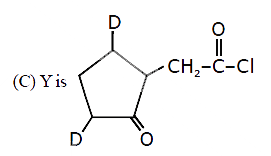Oxide of a metal on treatment with water produces a hissing sound and energy. The product (Y) formed on treatment with hydrochloric acid gives a solid X. Identify the oxide, the product (Y) and X. Also write all the balanced chemical equations and calculate molecular masses of the oxide, the product Y and X
To solve the question step by step, we will identify the metal oxide, the product formed when it reacts with water, and the solid produced when this product reacts with hydrochloric acid. We will also write the balanced chemical equations and calculate the molecular masses of the substances involved.
Step 1: Identify the Metal Oxide
The metal oxide that produces a hissing sound and energy when treated with water is Calcium Oxide (CaO). This reaction is exothermic and produces calcium hydroxide.
Hint: Look for metal oxides that react vigorously with water.
Step 2: Reaction of Calcium Oxide with Water
When calcium oxide reacts with water, it forms calcium hydroxide. The balanced chemical equation for this reaction is:
CaO (s)+H2O (l)→Ca(OH)2(aq)
The product formed, which we will denote as Y, is Calcium Hydroxide (Ca(OH)₂).
Hint: The reaction of metal oxides with water often produces hydroxides.
Step 3: Reaction of Calcium Hydroxide with Hydrochloric Acid
Next, we treat calcium hydroxide with hydrochloric acid. The balanced chemical equation for this reaction is:
Ca(OH)2(aq)+2HCl (aq)→CaCl2(aq)+2H2O (l)
The solid produced from this reaction, which we will denote as X, is Calcium Chloride (CaCl₂).
Hint: When a base reacts with an acid, it often produces a salt and water.
Step 4: Calculate Molecular Masses
Now, we will calculate the molecular masses of the substances involved.
1. Molecular Mass of Calcium Oxide (CaO):
- Calcium (Ca): 40 g/mol
- Oxygen (O): 16 g/mol
- Total: 40+16=56g/mol
2. Molecular Mass of Calcium Hydroxide (Ca(OH)₂):
- Calcium (Ca): 40 g/mol
- Oxygen (O): 16 g/mol (2 O in hydroxide)
- Hydrogen (H): 1 g/mol (2 H in hydroxide)
- Total: 40+(2×16)+(2×1)=40+32+2=74g/mol
3. Molecular Mass of Calcium Chloride (CaCl₂):
- Calcium (Ca): 40 g/mol
- Chlorine (Cl): 35.5 g/mol (2 Cl in the compound)
- Total: 40+(2×35.5)=40+71=111g/mol
Summary of Results
- Metal Oxide (CaO): Calcium Oxide
- Product Y (Ca(OH)₂): Calcium Hydroxide
- Solid X (CaCl₂): Calcium Chloride
- Molecular Mass of CaO: 56 g/mol
- Molecular Mass of Ca(OH)₂: 74 g/mol
- Molecular Mass of CaCl₂: 111 g/mol
The metal oxide that produces a hissing sound and energy when treated with water is Calcium Oxide (CaO). This reaction is exothermic and produces calcium hydroxide.
When calcium oxide reacts with water, it forms calcium hydroxide. The balanced chemical equation for this reaction is:
Next, we treat calcium hydroxide with hydrochloric acid. The balanced chemical equation for this reaction is:
Now, we will calculate the molecular masses of the substances involved.
- Calcium (Ca): 40 g/mol
- Oxygen (O): 16 g/mol
- Total: 40+16=56g/mol
- Calcium (Ca): 40 g/mol
- Oxygen (O): 16 g/mol (2 O in hydroxide)
- Hydrogen (H): 1 g/mol (2 H in hydroxide)
- Total: 40+(2×16)+(2×1)=40+32+2=74g/mol
- Calcium (Ca): 40 g/mol
- Chlorine (Cl): 35.5 g/mol (2 Cl in the compound)
- Total: 40+(2×35.5)=40+71=111g/mol
- Metal Oxide (CaO): Calcium Oxide
- Product Y (Ca(OH)₂): Calcium Hydroxide
- Solid X (CaCl₂): Calcium Chloride
- Molecular Mass of CaO: 56 g/mol
- Molecular Mass of Ca(OH)₂: 74 g/mol
- Molecular Mass of CaCl₂: 111 g/mol
Topper's Solved these Questions
- AIR AND OXYGENBook:PEARSON IIT JEE FOUNDATIONChapter:AIR AND OXYGENExercise:SHORT-ANSWER TYPE QUESTIONS
Explore 15 Videos
- AIR AND OXYGENBook:PEARSON IIT JEE FOUNDATIONChapter:AIR AND OXYGENExercise:ESSAY TYPE QUESTIONS
Explore 5 Videos
- ATOMIC STRUCTUREBook:PEARSON IIT JEE FOUNDATIONChapter:ATOMIC STRUCTUREExercise:Level 3
Explore 10 Videos
Similar Questions
Oxide of a metal on treatment with water produces hissing sound and energy.The product (Y) formed on treatment with hydrochloric acid gives a solid 'X'. ldentify the oxide, the product (Y) and X . Also write all the balanced chemical equations and calculate molecular masses of the oxide, the product (Y) and X .
View SolutionCalcium hydroxide on heating gives a solid product 'X' and on treatment with hydrochloric acid gives another solid product Y. What do you observe whe X and Y are exposed to atmosphere? Explain.
View Solution
Knowledge Check

Identify the product X and Y.AX is Cl−O||C−C||O−CH2ClB C
C DY is ClCO−C||O−CH3
DY is ClCO−C||O−CH3
The product X on oxidation with HIO4 gives :AHCHOBCH3−CHOCCO2DHCOOH
Calcium hydroxide on heating gives a solid product 'X' and on treatment with hydrochloric acid gives another solid product Y. What do you observe whe X and Y are exposed to atmosphere? Explain.
View SolutionAn element X on treatment with oxygen gives Y which on hydrolysis produces Z.Z on treatment with higher oxide of carbon 'A' gives milky white precipitate 'B'. Identify X, Y, Z, A and B?
View SolutionAn element X on treatment with oxygen gives Y which on hydrolysis produces Z.Z on treatment with higher oxide of carbon 'A' gives milky white precipitate 'B'. Identify X, Y, Z, A and B?
View SolutionIdentify the products (X) and (Y) in the given reaction:

View SolutionA student was studying combination reaction by adding few pieces of calcium oxide to water taken in a beaker.
a. Number the product formed.
b. Write the balanced chemical equation for the reaction.
View SolutionA straight chain saturated hydrocarbon wihth vapour density 43 on heating in absence of air gives X and y.y on treatment with bromine water gives Z identify X,Y and Z.
View Solution